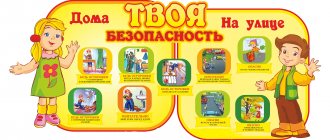The concept of a health-preserving environment
A health-saving environment is favorable living conditions in a particular area.
As for the health-preserving environment of a preschool educational institution, it is an educational space built on the principles of a healthy lifestyle, i.e. educational conditions have a positive effect on personal development, do not harm health, but help in maintaining and strengthening it.
Creating a health-preserving environment in a preschool institution is necessary for the full intellectual, communicative, social, creative and physical development of the younger generation.
Safe, productive development of a child’s personality includes the following aspects:
- A harmonious combination of spiritual and moral development;
- Socialization of the individual, its positive course;
- Focusing on the emotional component of educational and other activities;
- Maintaining mental and physical development at the proper level;
- Manifestation of social activity in all spheres of life and relationships.
Are you an expert in this subject area?
We invite you to become the author of the Directory Working Conditions A preschool educational institution is a microenvironment in which the social development of personality is realized. it requires the formation of a healthy mental climate, in compliance with the standards of hygiene, morality and aesthetics. In this regard, the health-preserving environment of a preschool educational institution is a combination of the following components:
- Education of the spiritual and moral principles of the individual.
- Eliminating the possibility of developing stressful situations in the educational process and smoothing them out when they arise.
- Maintaining hygiene of intellectual and physical work.
- Aesthetics of the surrounding space.
- Balanced diet.
- Maintaining a daily routine.
Thus, the creation of a health-preserving environment in a preschool educational institution involves careful design of the living conditions of children, observing hygiene standards and creating a comfortable psychological microclimate in a particular age group.
Conditions for organizing a health-preserving environment for preschool educational institutions
The organization of a health-preserving environment in a preschool educational institution is implemented with a focus on the following operating conditions:
Finished works on a similar topic
Course work Creating a health-preserving environment in a preschool educational institution 480 ₽ Abstract Creating a health-preserving environment in a preschool educational institution 270 ₽ Test work Creating a health-preserving environment in a preschool educational institution 210 ₽
Receive completed work or specialist advice on your educational project Find out the cost
- Comprehensive and systematic inclusion of physical activities in life. Regular physical activity is expected - gymnastics, exercises, outdoor games;
- Reliance in the educational process on the traditions and culture of a specific region, a specific locality, as well as national characteristics and cultural identity of the state.
- Partnership between teachers, students and their parents in working to preserve health. Promotion of a healthy lifestyle is carried out not only among students, but also among parents. Also, teachers of preschool educational institutions, by personal example, must demonstrate active work to preserve, maintain and strengthen health.
- Motivating preschoolers to acquire knowledge about health and its preservation and developing the need to comply with hygiene rules and other requirements that contribute to the preservation of health.
- Creation of a subject-development environment in preschool educational institutions and individual groups, focused on the full development of pupils and their comfort.
- Regularly diagnosing the health status of pupils and carrying out preventive measures (during seasonal diseases, prevention of vitamin deficiency, etc.).
ORGANIZATION OF A HEALTH-FREE EDUCATIONAL ENVIRONMENT IN PRESCHOOL EDUCATION INSTITUTIONS
ORGANIZATION OF A HEALTH-FREE EDUCATIONAL ENVIRONMENT IN PRESCHOOL EDUCATION INSTITUTIONS
The priority goal of an innovative preschool institution is to develop in children the motivational sphere of hygienic behavior, safe life, a value-based attitude to health and the implementation of acquired knowledge and ideas in behavior. The success of health-preserving activities will be achieved through the creation of a health-preserving educational environment. The article examines the essence of the concept of “health-saving educational environment” in a preschool education institution, reveals its content and characteristics. The issues of organizing a health-preserving educational environment within the framework of key areas are substantiated: personality-oriented, social, organizational-methodological and subject-spatial development.
Key words: health-preserving educational environment, health-preserving activities, health-preserving competence, valeological literacy, innovative health-preserving technologies.
The issues of preserving and strengthening the health of preschool children in the modern sociocultural space are a priority, requiring active action, first of all, on the part of pedagogical science, since the phenomenon of health itself is the most important socially significant value, an indicator of vitality and comprehensive harmonious development of the individual.
Many domestic and foreign scientists are studying the problem of creating a health-preserving educational environment in preschool educational institutions, studying psychological and pedagogical conditions and the peculiarities of constructing such an environment: T.K. Andryushchenko, D.V. Rotfort, N.V. Levinets, L.N. Voloshina, T.S. Ovchinnikova, L.V. Lokhvitskaya, V.N. Rostovtsev, V.N. Shebeko, Yu.N. Kislyakova S. Stevenson and others. However, its relevance today has been proven by the following factors: stressful tactics of psychological and pedagogical influences (the organization of the educational system of preschool education institutions is not fully focused on preserving the health of children, allows for systematic mental, intellectual and physical overload, the occurrence of situations of experience in play and communication); The readiness of teachers to work in conditions of priority of health and the implementation of professional activities on the basis of health-saving principles has not been formed; insufficient equipment of the scientific and methodological base, organizational-spatial, subject-spatial environment of preschool education institutions, valeological illiteracy of parents of pupils, etc.
A health-saving educational environment in a preschool education institution is a socio-cultural space of a group that allows you to create pedagogical conditions for the positive socialization of children in the field of leading a healthy lifestyle, creating material and spiritual conditions for health-oriented activities, demonstrating the nature-like needs of a developing personality in health conservation. Being one of the innovative areas of work for a teacher, this area involves solving the following problems: organizing work with the greatest effect for preserving and strengthening health; creating conditions for children to feel joy during the learning process; developing the ability to live in harmony with oneself and the surrounding world; fostering a culture of health; development of creative abilities; motivation for a healthy lifestyle; teaching children to use the acquired knowledge in everyday life; introduction of innovative pedagogical technologies [p. 310-316.].
O.E. Podgornaya and L.N. Voloshin offer a synonymous definition of the definition of “health-saving educational environment”, considering this phenomenon as a “health-saving educational space” and justify it as a multi-level educational system, a socially organized educational environment, part of a pedagogically meaningful reality that integrates the potential of educational institutions, the socio-cultural sphere, the family, child, as well as systems of interactions aimed at increasing his physical education and health capabilities. Such an environment, according to researchers, ensures that its subjects understand the value of a healthy lifestyle, preserving and strengthening health, the productive activity of all participants in the space in developing the skills of a culture of health and spiritual and moral self-improvement (health-saving educational process) to preserve and strengthen the health of children [6; 3].
According to research results by I. A. Anokhina, a health-preserving environment in a preschool educational institution should include:
— conditions for a favorable course of adaptation to kindergarten;
- a comfortable subject-development environment in the group and an atmosphere of emotional comfort for each child;
— conditions for the formation of the foundations of a culture of health and healthy lifestyle habits, a health-saving component;
— organizing activities that are interesting for children;
— an individual approach to the child from the moment of admission to a preschool institution until graduation from school [2 p. 3-11].
The formation of a health-saving educational environment in a preschool education institution, in our opinion, should be implemented in four directions:
• personality-oriented direction;
• social direction;
• organizational and methodological direction;
• subject-spatial developmental direction.
Within the framework of the personality-oriented direction, when organizing the health improvement of preschool children in a health-preserving environment, it is assumed that the natural process of self-development and creative potential of the individual will be supported, which provides for:
• a psychologically comfortable space that helps meet the needs for personal and confidential communication;
• forecasting the manifestations of individual characteristics of physical fitness;
• a system of comprehensive preventive medical care (carrying out medical-physiological, sociological, psychological and pedagogical monitoring of the health status of children);
• inclusion of preschoolers in various types of motor activities for the purpose of mandatory development, improvement and monitoring of the growth of motor skills.
Personality-oriented direction, as noted by T.A. Andryushchenko, provides psychological comfort in the process of children consolidating health-saving life skills, the implementation of an individual approach to students, the absence of stressful situations, as well as a positive example of significant adults [1, pp. 6-12.].
The social direction involves the health-saving activities of the teaching staff of preschool educational institutions as part of the development of health-saving competence in them, the valeological literacy of parents of pupils (propaganda and educational activities), as well as cooperation and interaction between teachers and parents in the health-saving sphere as participants in the health-saving educational process (consulting work in within the framework of educational work, seminars, educational work).
As part of the methodological work of a preschool institution, the effectiveness of the formation of health-preserving competence of preschool teachers will be achieved through the use of interactive technologies that perform not only educational and cognitive, but also communicative, developmental and socially oriented functions. In this case, the following can be actively used:
• positional technology of interactive learning N.E. Veraxes (active discussion of the content, forms, methods of health conservation in a preschool institution in problem groups “Question”, “Opposition”, “Expert”, etc.);
• methods of brainstorming and heuristic conversation (lectures-visualization, problem-based seminars, reflective workshops, during which issues of forming and strengthening the health of students and families are considered);
• case study method (discussion and analysis of pedagogical situations and tasks taken from the real practice of health-preserving activities of preschool educational institutions);
• method of integral body therapy (awareness of the connections between bodily sensations and emotional experiences or processes, for example, the “Dancing Point” exercise);
• method of business games (imitation of situations simulating health-preserving, health-forming activities, in a playful way;
• project method (designing a model of health-saving activities of a preschool educational institution with subsequent presentation of the finished product; conducting thematic monitoring of the effectiveness of health-saving in a preschool institution and family; child-parent fitness programs);
• information and computer technologies (participation of teachers with their health-saving projects and consultations in the pedagogical Internet club, virtual parenting academy, etc.) [5].
Psychological and pedagogical education of parents in order to improve their pedagogical culture and competence in matters of preserving and strengthening the health of children is one of the areas in cooperation between a preschool institution and a family. The methodology of joint work to develop valeological literacy of parents in the field of health conservation assumes: unity of goals and objectives of raising a healthy child in a preschool educational institution and family; an individual approach to each child and each family, systematic and consistent work throughout the entire period of the child’s stay in kindergarten; mutual trust and mutual assistance between teachers and parents; strengthening the authority of teachers in the family, and parents in kindergarten; developing an attitude towards parents as equal partners in educational work [7].
The organizational and methodological direction is characterized by a safe health-preserving infrastructure, including material, technical, sanitary, hygienic and methodological (carrying out sports and recreational activities, improving methods aimed at developing the health-preserving competence of preschool children) conditions. An important aspect is the introduction of innovative health-saving technologies into the educational process of preschool educational institutions. Today, the following types of health-saving technologies in preschool education can be distinguished: medical and preventive (biofeedback (BF), acupressure, self-massage); physical education and health (rhythmoplasty, relaxation, gymnastics: orthopedic, corrective, breathing, for the eyes, etc.); technologies for ensuring the socio-psychological well-being of the child (communicative games, problem-based game training); correctional technologies (psycho-gymnastics, phonetic rhythms, art therapy, behavior correction technologies).
The modern context of creating a health-saving subject-spatial development environment involves the use of material and technical resources along with scientific and methodological ones, as well as the creative potential of the teaching staff. An example for such an environment in a preschool educational institution is the creation in the educational space of a group of children's activity centers that promote physical, social, mental and spiritual health. For example, the “Cognition Center” provides solutions to the problems of cognitive and research activities of children (educational and logical games, speech games, games with letters, sounds and syllables; experiments and experiments; information and communication tools that allow enhancing the effect of immersion in an imaginary situation with using virtual reality projections, multimedia presentations and clipart.), “Physical training and health center” provides physical activity and organization of health-preserving activities for children, a specially equipped sensory room, as an environment organized in a certain way, including many different kinds of stimulants that affect the organs of vision , hearing, smell, touch, vestibular receptors, etc. The formation of a health-saving developmental subject-spatial environment in a preschool educational organization, which is saturated with various materials, means, objects, allows the child, through natural curiosity in play activities, to master approaches to maintaining a healthy lifestyle, creatively transform received ideas, demonstrate in situations of choice new, introduced ideas about elements that are focused on preserving, strengthening and developing individual health [4, p. 32-42].
Thus, based on the above, it should be noted that a health-preserving educational environment in a preschool education institution, being one of the priority areas of scientific research, not only ensures the preservation and strengthening of health, but also creates a culture of health; serves as the basis for the formation of a value-based attitude towards health; encourages the child to be active and take independent initiative in leading a healthy lifestyle; allows you to transform acquired knowledge and ideas in practical activities; serves as an incentive for self-realization of preschool children, being the basis for the comprehensive development of the child’s personality. In addition, the formation of such an environment will be successfully implemented through the interaction of all subjects of the educational process.
List of sources used
- Andryushchenko T.K. Providing a health-preserving environment for preschoolers to consolidate life skills that contribute to maintaining health. Collection of scientific reports. Pedagogy. Scientific proposals. Part 2. 2015. - pp. 6-12.
- Anokhina I. A. Conditions for ensuring the social and emotional well-being of children in preschool educational institutions // Primary school plus before and after. 2013. No. 6. - P. 3-11.
- Voloshina L.N. Development of a health-saving educational space in preschool institutions (methodology, theory, practice: dissertation ... Doctor of Pedagogical Sciences: 13.00.04 / L.N. Voloshina - Ekaterinburg, 2006. 434 p.
- Zverkova A. Yu. Health-saving activities of a teacher in accordance with the professional standard // Modern scientific research: methodology, theory, practice: materials of the VI international scientific and practical conference (Chelyabinsk, February 23, 2015). - Chelyabinsk: City-Print, 2015. - pp. 32-42.
- Miklyaeva N.V. “Physical development of preschool children. Part 1. Health protection and promotion / Ed. N.V., Miklyaeva. – M.: Sfera, 2015. – 144 p.].
- Podgornaya O. E. Design of a health-preserving space in a comprehensive school using the means of personality-oriented education: dis. ...cand. ped. Sciences: 13.00.01 / O. E. Podgornaya - Tiraspol, 2005. 211 p. P. 17.
- Runova M.A. Motor activity of a child in kindergarten: 5–7 years old: a manual for teachers of preschool institutions, teachers and students of pedagogical universities and colleges / M.A. Runova - Moscow: Mosaika-Sintez, 2000. 256 p.
- Sedletskaya T.V. Innovative educational environment in the system of health-promoting activities of an educational institution in modern Russia. I Luga Scientific Readings. Modern scientific knowledge: theory and practice. Materials of the international scientific and practical conference. Rep. ed. T.V. Sedletskaya. 2013 Publisher: Leningrad State University named after. A.S. Pushkin (St. Petersburg) May 22, 2013, pp. 310-316.
SUMMARY AND ORGANIZATION OF HEALTH EDUCATIONAL ENVIRONMENT IN PRESCHOOL EDUCATIONAL INSTITUTIONS
The priority objective of the innovative pre-school is to form children's motivational sphere of hygienic behavior, safe life, physical training and the implementation of learned knowledge and understanding in their behavior. The success of this will be achieved through the creation of health-educational environment. The article deals with the essence of the concept of “health-educational environment” in the establishment of pre-school education, disclosed its contents and characteristics. Substantiates the organization of health-environment within key areas: student-oriented, social, organizational and methodical and detail-spatial developmental.
Keywords: health-educational environment, health-saving activity, health-competence, valeological literacy, innovative health-saving technologies.




